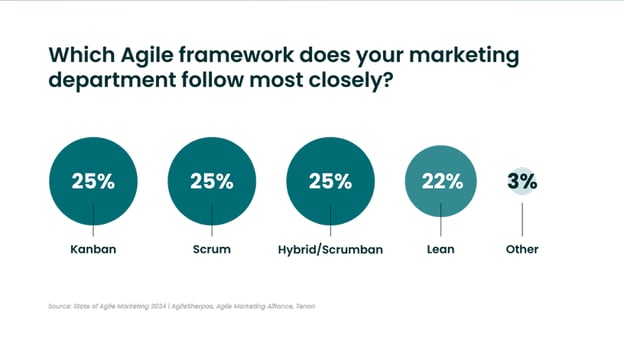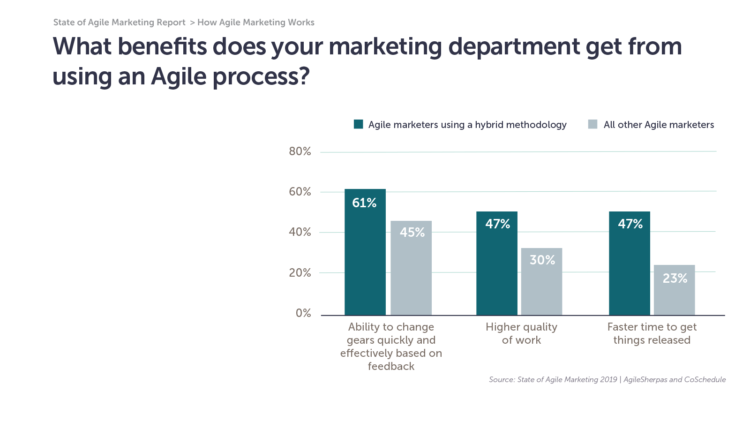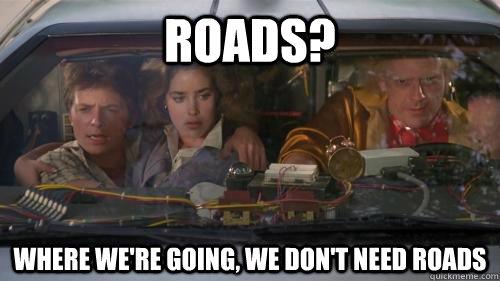Like many Agile marketers, one of the first things I did after discovering Agile marketing was run out and become a Certified Scrum Master. I added the Product Owner certification shortly after, and proceeded to turn my unsuspecting marketing department into two Scrum teams.
Within just a few months, however, the cracks in this most popular framework started to show. The product development team was unexpectedly early with a new feature release (they were Agile too, after all), and they needed marketing support in the middle of our Sprint. So long, Sprint plan.
Our hands-on CEO read an AMAZING book about marketing and decided we needed to chase a new shiny objective, or channel, or audience segment. See ya later, carefully crafted backlog. And so it went, until I threw up my hands and went back to the methodology drawing board.
Kanban, I decided, was what we needed. No sprints, more flexible planning, and *gasp* limits on how much work we would do at a time?! Brilliant! But our leadership missed the Sprint structure. They felt that Kanban wasn’t giving them the predictability they were getting from the developers who were (mostly) using Scrum. Thus was born my first ever hybrid Agile marketing team, a deliberate Scrumban implementation that delivered the cadence of Scrum with the limited WIP of Kanban.
Data on Hybrid Agile Marketing Methodologies
In the years since, I’ve worked with hundreds of Agile marketers whose experiences mirror my own early attempts to adapt Agile methodologies to marketing work. The off-the-shelf versions just don’t cut it, and we end up building our own custom approaches. This year, in our Seventh Annual State of Agile Marketing Report, I’m delighted to say that we can not only show you how much more common these hybrid methodologies are, we can even show you that they’re as popular as the leading Agile frameworks like Scrum and Kanban.

First of all, here’s the data on the popularity of hybrid Agile marketing methodologies. You can see that 25% report using a hybrid of some kind.
To be clear, we didn’t specify in the question exactly what kind of hybrid teams are using. My qualitative interviews with various teams puts them all over the map. Some are deliberately crafting a Scrumban approach, while others are using mostly Scrum practices with their own flavor. And, speaking of Scrumban, we did offer that as a unique choice deliberately. Scrumban isn’t a very well known or commonly used methodology, even inside of traditional Agile environments. So we didn’t want to limit hybrid teams to only this option.
Benefits of Hybrid Agile Marketing Methodologies
This pick-and-choose framework is something I’ve been preaching for a while, and it’s central to the way we train here at AgileSherpas. When I was helping write the ICAgile curriculum for their Agile marketing certification, ensuring that the courses covered all the major frameworks was a key objective for all the course designers. So I was ecstatic this year when digging through our State of Agile Marketing data to find a strong correlation between using hybrid methodologies and getting benefit from Agile marketing:
Here we’re comparing those Agile marketers who told us they use a hybrid methodology with those using all the other methodologies. You can see that hybrid teams are 16% more likely to be able to change gears quickly, 17% more likely to produce high quality work, and 24% more likely to release faster. Ultimately, this is the path forward for Agile marketing. It’s time for us to truly build our own Agile adventure.
Shu Ha Ri and Agile Marketing
This year’s data has really driven home to me the evolving nature of Agile marketing. I believe that we’re transitioning into a Ri state after spending the past several years in Ha. I realize that last sentence makes very little sense to most readers, so let me back up. The concept of Shu Ha Ri originates in Japanese martial arts, and refers to the stages of learning and mastery.
Image source: KnowledgeBlob
Phase 1: Shu
Literally translated as “protect” or “obey,” this stage is all about obeying the rules. You learn the fundamentals and follow them rigorously. In the world of Agile marketing, this happened during the earliest explorations of the concept, around 2010-2011. Forward-thinking marketers began to recognize the brokenness of their processes, and started looking to Agile as a solution.
They followed the most well-known Agile framework, Scrum, as closely as they possibly could. A few were Kanban adherents, but in both cases it was about looking at the existing playbook and following along. (Important note: While the movement as a whole has largely moved away from this phase, many new Agile marketing teams still need to start in the Shu phase as they get comfortable with Agile ways of working.)

Phase 2: Ha
In Japanese Ha means to “detach” or “digress,” and it’s here where learners begin to break with tradition. Now that you know the moves, you can begin to improvise around them. Think about dancing -- you have to learn and follow the steps before you can go forward. Agile methodologies in marketing work much the same way. We learned and followed Scrum and Kanban, but through those efforts we began to improvise and create our own methods. Those new frameworks are still very recognizable as adaptations of the originals, but they’re another stage of evolution.
In our Agile Marketing Fundamentals course, for example, we try to help our students get here by the end of the workshop so they can be comfortable designing their own custom Agile marketing methodology.
Phase 3: Ri
In this final phase of mastery we “leave” or “separate,” creating our own new moves and techniques. Really amazing martial artists and dancers and musicians live in Ri. They’ve spent so much time practicing and perfecting their craft that they’ve transcended its boundaries. They’re creating something new. It’s still recognizable as martial arts or dancing or music, but it’s unique. This, I believe, is where Agile marketing is heading. Soon we won’t need traditional Scrum or Kanban frameworks to provide guard rails, because our practice will allow us to separate from those traditions.

Note that I say “separate,” not reject. I’m not implying that Scrum and/or Kanban should be abandoned by marketers, simply that we’re just about ready to forge our own unique path. This is something that you’ll be hearing more about from AgileSherpas in the coming months, so if you’re not an email subscriber now would be a great time to do that. Those folks will be getting all kinds of sneak peeks very soon ;)
What Do You Have to Ri-port?
But don’t take my word for it! I’d love to hear your experiences as an Agile marketer. Are you (or have you ever) used a hybrid Agile marketing methodology? Did you find it useful? Let us know in the comments!